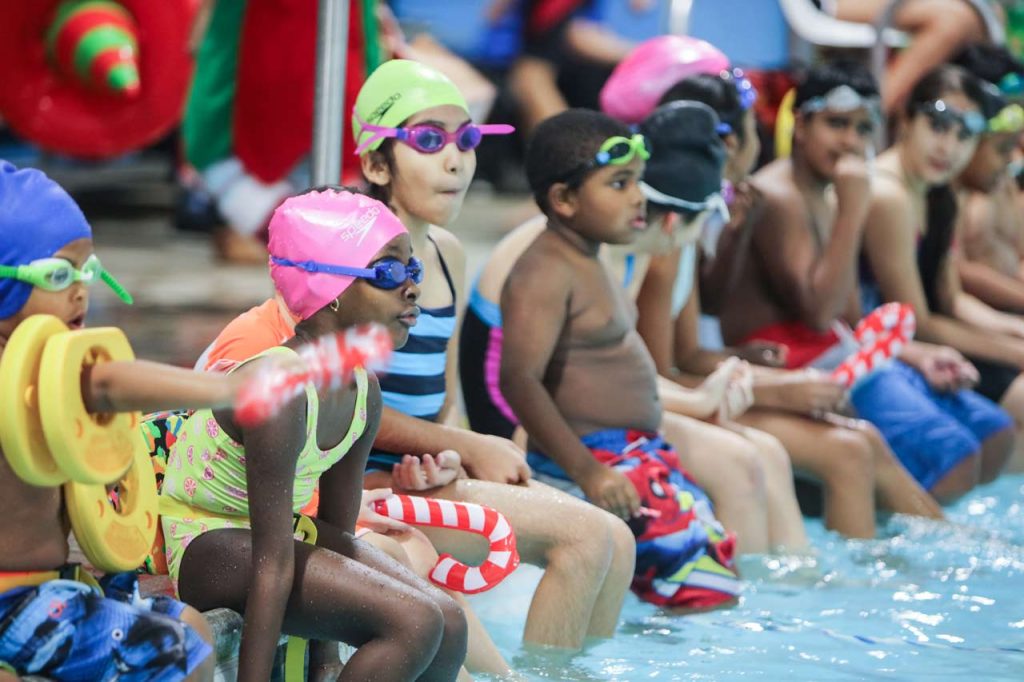
Dive into Excellence — Where Fitness Meets Future Champions
At Colvin Taluqdars’ College, we believe in nurturing not just minds, but also bodies and character. Our state-of-the-art Swimming Facility stands as a testament to our commitment to holistic student development—combining athleticism, discipline, and health. Swimming at Colvin is not just a sport—it’s a journey toward excellence, resilience, and lifelong well-being.
World-Class Pool Infrastructure
Our campus proudly features a modern semi-Olympic (25-meter) swimming pool, designed for daily training, recreation, and competition.
-
Multiple depth zones cater to beginners and advanced swimmers alike, including safe diving areas with approved springboards.
-
The indoor, climate-controlled pool facility ensures uninterrupted training all year round, regardless of weather.
-
Anti-slip pool decks and a designated spectator gallery make it ideal for hosting competitive and community events.
-
Modern changing rooms with private lockers and showers offer students convenience and hygiene.
Professional Coaching & Training Programs
Swimming at Colvin is guided by certified and experienced swim coaches, proficient in nurturing talent across all levels.
-
Our tiered training programs serve beginners, intermediate learners, and competitive swimmers.
-
In addition to in-pool training, we integrate dry-land conditioning including strength, flexibility, and breathwork exercises.
-
Students benefit from individual coaching sessions and team-based practices that emphasize technique and camaraderie.
Top-Tier Equipment & Safety Standards
We ensure the highest level of safety and performance:
-
Access to professional-grade training equipment like kickboards, resistance paddles, pull buoys, and fins.
-
Trained lifeguards on duty at all times, supported by comprehensive life-saving gear.
-
Students are equipped with performance swimwear, goggles, and caps, promoting discipline, hygiene, and unity.
Competitive Edge & Signature Events
The swimming program at Colvin fuels a competitive spirit:
-
We conduct regular intra-college swim meets and proudly represent Colvin at district and state-level championships.
-
Our facility is capable of hosting regional competitions, elevating our status in the school sports ecosystem.
-
Events like Alumni Swim Day, Family Water Fests, and Summer Swim Galas foster a joyful and inclusive swim culture.
Skill Development & Technique Mastery
Training at Colvin focuses on precision, power, and endurance:
-
Students develop fluency in all major strokes: freestyle, backstroke, breaststroke, and butterfly.
-
Emphasis is placed on diving, starts, flip turns, and race pacing.
-
Breathing drills, lap endurance, and underwater techniques ensure each swimmer grows in form and fitness.
Physical & Mental Wellness Through Swimming
Swimming contributes significantly to a student’s overall well-being:
-
A low-impact, full-body workout that builds strength, stamina, flexibility, and cardiovascular health.
-
Programs include injury prevention warm-ups and cool-down stretches for sustainability.
-
The sport enhances mental clarity, focus, discipline, and emotional regulation, benefiting academic and personal life alike.
Career Pathways & Lifelong Opportunities
We support students not only in the water but beyond:
-
Scholarships and talent mentorship for promising swimmers.
-
Opportunities to enter competitive leagues through collaboration with local and national swimming federations.
-
Lifeguard and swim instructor certifications prepare students for careers in safety, coaching, and fitness.
Community Engagement & Enrichment
Colvin’s swimming program reaches beyond the campus:
-
We host seasonal swim camps and skill clinics led by top coaches.
-
Water safety and rescue training is provided for students and the surrounding community.
-
Alumni engagement, inter-batch competitions, and fun family events make swimming a unifying force across generations.
Balancing Academics & Athletics
Colvin ensures that student-athletes thrive in both pool and classroom:
-
Flexible schedules help balance training and academics effectively.
-
Academic support and tutoring are provided during competition seasons.
-
Swimming fosters key life skills—time management, goal setting, teamwork, and resilience.
Institutional Impact: A Vision for the Future
The swimming facility has become a source of institutional pride and student well-being at Colvin Taluqdars’ College:
-
It enhances the college’s reputation as a leader in sports and wellness education.
-
Attracts and retains students seeking a well-rounded, progressive academic environment.
-
Promotes a culture of fitness, unity, and achievement, reflecting our core values.
Making Waves at Colvin
With a premier Swimming Facility in place, Colvin Taluqdars’ College dives headfirst into a future where fitness fuels confidence, discipline shapes leaders, and every student has the chance to excel in the pool and in life.
